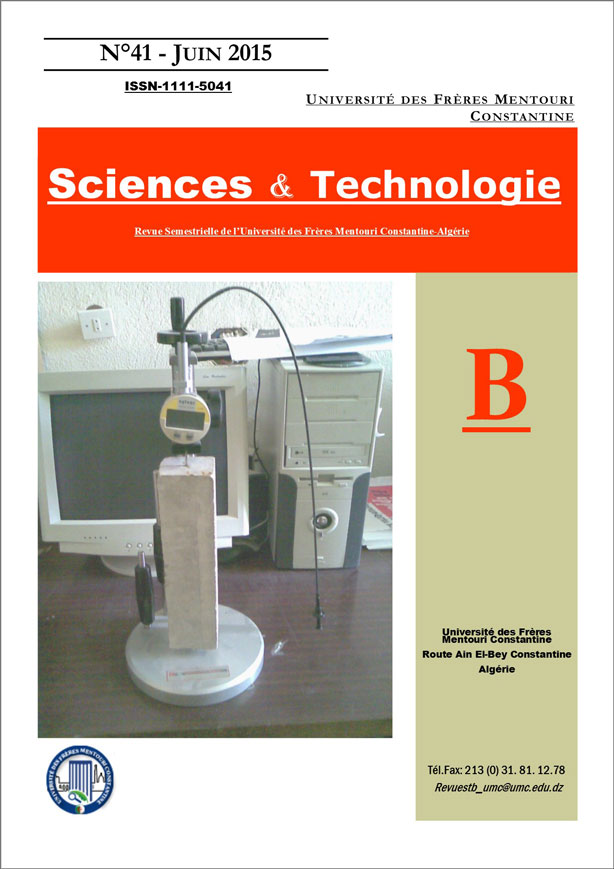DYNAMIC ANALYSIS OF DISCRETE MECHANICAL STRUCTURES USING THE BEAM FINITE ELEMENT METHOD UNDER DIFFERENT LIMIT CONDITIONS
Mots-clés :
Discrete structures, beam finite element, rigidity and mass matrix, nodal displacements, thrust loads, energy deformation, vibration modesRésumé
The discrete structures are of great importance in the application fields of mechanical, aeronautical and civil engineering. They are composed of truss, beam or lattice elements assembled together by welding or riveting in two or three dimension. Such structures can be of big dimensions and characterized by high rigidities of stress and important qualities of resistance with a minimum weight, which allow them to be used in many mechanical systems, metal frames and aerospace structures. However, during their lifetime, these types of structures are subjected to considerable external forces or strong vibration amplitudes that may cause them to large deformations or even their destruction. Consequently, the static and dynamic concept analysis of these structures is recommended, and due to their complexity form, the finite element method has been used. It is knotted that each discrete element of the structure is modeled as a continuum beam element where its mass and rigidity matrices has been determinated using the energy method and after the assembly the hall matrices of the hall structure can be obtained.
In fact, the finite element method is used to solve problems by dividing the deformable body in a complicated assembling sub domain form or by constructing single elements and the approximate solutions in the form of a combination of shape functions and compact supports. The excitation forces are based on periodic, random or impulsive ones. In our case, we present a numerical solution to describe the dynamic behavior of discrete structures which have applications of big importance in many sectors of engineering and industry. Nowadays, this method is a powerful tool, available for reasonable costs with a reduced time of execution used for the analysis of these structures. In our work, we have developed a Pascal language program, to calculate the displacements, reactions in nodes, the axial strengths in elements and the clean fashions of the structure under different limit conditions. Examples of verification of the developed language have been made, under different loads and boundary conditions in static and dynamic cases, and good results have been obtained compared with those obtained using "SAP2000" and Robot2009 software programs.
Références
A. Fortin, Les éléments finis de la théorie à la pratique, Ecole polytechnique de Montréal, 2011.
El Ghazi,S. El Hajji, Guide d’utilisation du logiciel MATLAB, département mathématiques et informatique, Université Mohammed V, Maroc, 2004.
Pierre Spiteri, “ présentation générale de la méthode des éléments finis ”, Ecole nationale supérieur de Toulouse, article [AF505].
M.Lalanne,P.Berthier, J.DerHagobian , Mécanique des vibrations linéaires, MASSON Edition,1995.
T.Y. Yang,Finite element structural analysis, Prentice-Hall, 1986.
B. Necib, Théorie générale de la mécanique des milieux continus, Université Mentouri Constantine, 2010.
P. Trompette, Mécanique des structures par la méthode des éléments finis (Statique et dynamique), 1992.
M. Abdi, K. Mohamed, Numerical Simulation and Active Vibration Control of Piezoelectric Smart Structure. International Review of Mechanical Engineering. Vol3.,pp 175-181, 2009.
O.C. Zienkiewiez, The finite element method in engineering analysis, Paris, 1991.
A. Lebeid, B.Necib. Analysis and numerical modeling of ceramic piezoelectric beam, International Review of Mechanical Engineering. Vol 3, pp. 454-456, 2011.
N. Brie, Mise en œuvre d'un calcul de modes propres d'une structure, EDF R&D, 2014
B. Necib, Les méthodes des éléments finis (MEF), Université de Constantine, 2011.
Téléchargements
Publié-e
Comment citer
Numéro
Rubrique
Licence
Les auteurs publiant dans cette revue acceptent les termes suivants :- Les auteurs détiennent le droit d'auteurs et accordent à la revue
le droit de première publication, avec l’ouvrage disponible simultanément [SPÉCIFIER LA PÉRIODE DE TEMPS] après publication, sous la licence Licence d’attribution Creative Commons qui permet à d'autres de partager l'ouvrage en en reconnaissant la paternité et la publication initiale dans cette revue. - Les auteurs peuvent conclure des ententes contractuelles additionnelles et séparées pour la diffusion non exclusive de la version imprimée de l'ouvrage par la revue (par ex., le dépôt institutionnel ou la publication dans un livre), accompagné d'une mention reconnaissant sa publication initiale dans cette revue.
- Les auteurs ont le droit et sont encouragés à publier leur ouvrage en ligne (par ex., dans un dépôt institutionnel ou sur le site Web d'une institution) avant et pendant le processus de soumission, car cela peut mener à des échanges fructueux ainsi qu'à un nombre plus important, plus rapidement, de références à l’ouvrage publié (Consulter The Effect of Open Access).

